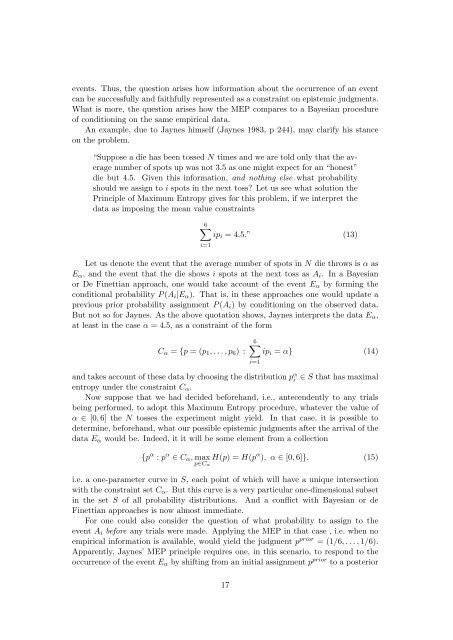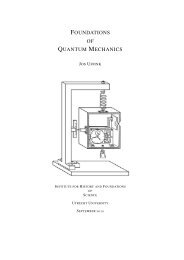Subjective probability and statistical physics
Subjective probability and statistical physics
Subjective probability and statistical physics
You also want an ePaper? Increase the reach of your titles
YUMPU automatically turns print PDFs into web optimized ePapers that Google loves.
events. Thus, the question arises how information about the occurrence of an event<br />
can be successfully <strong>and</strong> faithfully represented as a constraint on epistemic judgments.<br />
What is more, the question arises how the MEP compares to a Bayesian procedure<br />
of conditioning on the same empirical data.<br />
An example, due to Jaynes himself (Jaynes 1983, p 244), may clarify his stance<br />
on the problem.<br />
“Suppose a die has been tossed N times <strong>and</strong> we are told only that the average<br />
number of spots up was not 3.5 as one might expect for an “honest”<br />
die but 4.5. Given this information, <strong>and</strong> nothing else what <strong>probability</strong><br />
should we assign to i spots in the next toss? Let us see what solution the<br />
Principle of Maximum Entropy gives for this problem, if we interpret the<br />
data as imposing the mean value constraints<br />
6∑<br />
ip i = 4.5.” (13)<br />
i=1<br />
Let us denote the event that the average number of spots in N die throws is α as<br />
E α , <strong>and</strong> the event that the die shows i spots at the next toss as A i . In a Bayesian<br />
or De Finettian approach, one would take account of the event E α by forming the<br />
conditional <strong>probability</strong> P (A i |E α ). That is, in these approaches one would update a<br />
previous prior <strong>probability</strong> assignment P (A i ) by conditioning on the observed data.<br />
But not so for Jaynes. As the above quotation shows, Jaynes interprets the data E α ,<br />
at least in the case α = 4.5, as a constraint of the form<br />
C α = {p = (p 1 , . . . , p 6 ) :<br />
6∑<br />
ip i = α} (14)<br />
i=1<br />
<strong>and</strong> takes account of these data by choosing the distribution p α i ∈ S that has maximal<br />
entropy under the constraint C α .<br />
Now suppose that we had decided beforeh<strong>and</strong>, i.e., antecendently to any trials<br />
being performed, to adopt this Maximum Entropy procedure, whatever the value of<br />
α ∈ [0, 6] the N tosses the experiment might yield. In that case, it is possible to<br />
determine, beforeh<strong>and</strong>, what our possible epistemic judgments after the arrival of the<br />
data E α would be. Indeed, it it will be some element from a collection<br />
{p α : p α ∈ C α , max<br />
p∈C α<br />
H(p) = H(p α ), α ∈ [0, 6]}, (15)<br />
i.e. a one-parameter curve in S, each point of which will have a unique intersection<br />
with the constraint set C α . But this curve is a very particular one-dimensional subset<br />
in the set S of all <strong>probability</strong> distributions. And a conflict with Bayesian or de<br />
Finettian approaches is now almost immediate.<br />
For one could also consider the question of what <strong>probability</strong> to assign to the<br />
event A i before any trials were made. Applying the MEP in that case , i.e. when no<br />
empirical information is available, would yield the judgment p prior = (1/6, . . . , 1/6).<br />
Apparently, Jaynes’ MEP principle requires one, in this scenario, to respond to the<br />
occurrence of the event E α by shifting from an initial assignment p prior to a posterior<br />
17
















